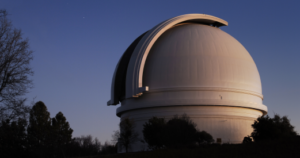Landmark telescope with a modern upgrade

- Telescope: Hale Telescope, 5.1 m
- Instrument: Cosmic Web Imager (CWI)
- Location: Palomar Observatory, San Diego County, California
>> At 5.1 m, the Hale Telescope became the largest effective telescope in the world when it was engineered in 1948, and it remained so for more than 25 years after. As such, it has played a pivotal role in our understanding of our solar system, other solar systems, and the galaxies beyond. It remains highly active as a research telescope thanks to the addition of adaptive optics in 1999, as well as new instruments like the Cosmic Web Imager (CWI), a UV-VIS imaging integral-field spectrograph. In addition to a medium resolution 385-560 nm reflective grating with resolution of 2000, the CWI hosts three large format VPH gratings from Wasatch Photonics, each yielding a spectral resolution of approximately 5000:
-
- Blue channel: 460-550 nm
- Yellow channel: 555-690 nm
- Red channel: 640-770 nm
The Cosmic Web Imager was designed to the detect regions of low surface brightness or “dim matter” that comprise most of the cosmic web – the intergalactic medium (IGM). It has been able to see the cosmic filaments of IGM when lit by nearby bright objects like quasars and Lyman-alpha blobs, including a 1 million light-years long filament flowing into a quasar, and other objects dating from roughly 2 billion years after the Big Bang, during a time of rapid star formation in galaxies. To learn more about CWI’s work, watch Palomar Observatory’s video talk “Observing the Largest Structures in the Universe”. Success of this instrument led to the design of a further optimized version for the Keck II telescope on Mauna Kea, Hawaii, the Keck Cosmic Web Imager (KWCI).
References
- Matuszewski, Mateusz et al., “The Cosmic Web Imager: an integral field spectrograph for the Hale Telescope at Palomar Observatory: instrument design and first results“, Ground-based and Airborne Instrumentation for Astronomy III. Vol 7735 International Society for Optics and Photonics, 2010.


